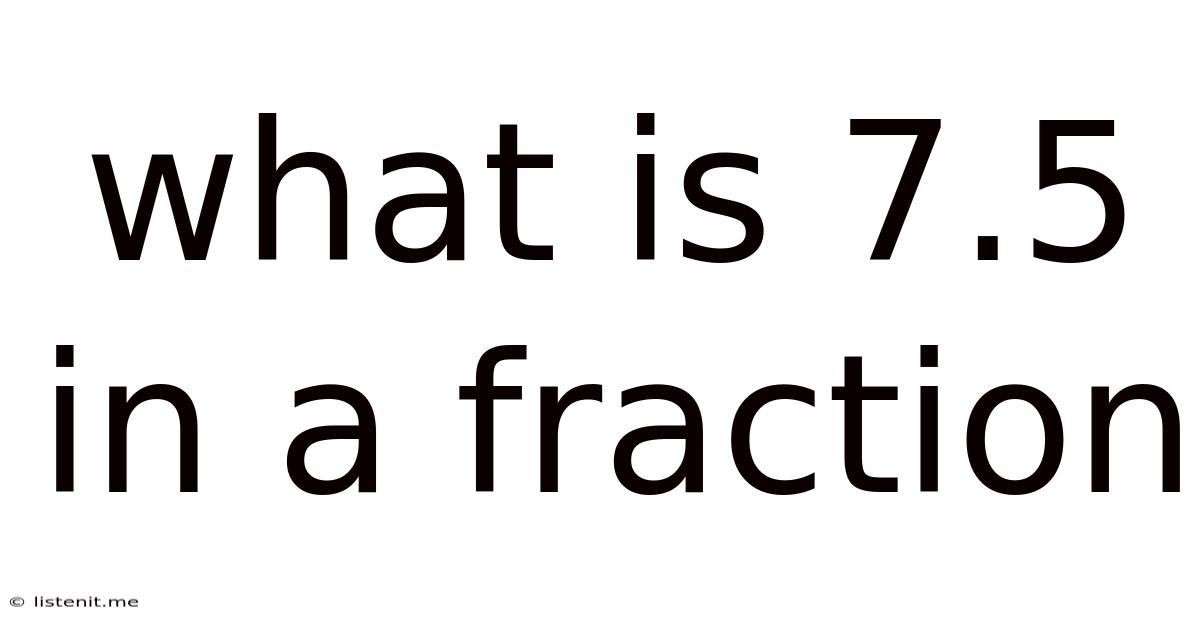What Is 7.5 In A Fraction
listenit
May 24, 2025 · 4 min read

Table of Contents
What is 7.5 as a Fraction? A Comprehensive Guide
The question "What is 7.5 as a fraction?" might seem simple at first glance, but it opens the door to understanding the fundamental relationship between decimals and fractions. This comprehensive guide will not only answer this specific question but also equip you with the knowledge to convert any decimal into a fraction, solidifying your understanding of mathematical representations.
Understanding Decimals and Fractions
Before diving into the conversion, let's clarify the concepts of decimals and fractions.
Decimals: Decimals represent parts of a whole using a base-ten system. The decimal point separates the whole number from the fractional part. Each digit to the right of the decimal point represents a power of ten: tenths, hundredths, thousandths, and so on. For example, 7.5 means 7 whole units and 5 tenths.
Fractions: Fractions represent parts of a whole using a numerator (the top number) and a denominator (the bottom number). The numerator indicates how many parts you have, and the denominator indicates how many parts make up the whole. For example, ½ represents one part out of two equal parts.
Converting 7.5 to a Fraction: Step-by-Step
Converting 7.5 to a fraction involves a straightforward process:
-
Identify the decimal part: In 7.5, the decimal part is .5.
-
Express the decimal as a fraction: .5 is equivalent to 5/10 because the 5 is in the tenths place.
-
Combine the whole number and fraction: Since 7.5 is 7 whole units and 5/10, we can represent this as 7 + 5/10.
-
Convert to an improper fraction (optional): To express this as a single fraction, we convert the whole number into a fraction with the same denominator: 7 = 70/10.
-
Add the fractions: 70/10 + 5/10 = 75/10
-
Simplify the fraction: Both the numerator (75) and the denominator (10) are divisible by 5. Simplifying gives us 15/2.
Therefore, 7.5 as a fraction is 15/2. This is also known as an improper fraction because the numerator is larger than the denominator. You can also express this as a mixed number: 7 ½.
Different Methods for Decimal to Fraction Conversion
While the above method is the most straightforward for 7.5, let's explore other approaches that are applicable to various decimals:
Method 1: Using the Place Value
This method directly utilizes the place value of the decimal digits. Let's look at a different example, converting 3.25 to a fraction:
-
Identify the decimal part: The decimal part is .25.
-
Determine the place value: The last digit (5) is in the hundredths place.
-
Express as a fraction: .25 = 25/100
-
Combine with the whole number: 3 + 25/100 = 3 25/100
-
Simplify: Both 25 and 100 are divisible by 25, resulting in 1/4. Therefore, 3.25 = 3 1/4 or 13/4.
Method 2: Multiplying by a Power of 10
This method is particularly useful when dealing with recurring decimals. For non-recurring decimals, it's essentially the same as the place value method. Let's convert 2.375:
-
Count the decimal places: There are three decimal places.
-
Multiply by 1000: (because 10 to the power of 3 is 1000) 2.375 * 1000 = 2375
-
Write as a fraction: 2375/1000
-
Simplify: Divide both numerator and denominator by 125 (a common factor): 19/8
Method 3: Handling Recurring Decimals
Recurring decimals (like 0.333...) require a slightly different approach. Let's look at converting 0.666... (0.6 recurring) to a fraction:
-
Let x = 0.666...
-
Multiply by 10: 10x = 6.666...
-
Subtract the original equation: 10x - x = 6.666... - 0.666...
-
Simplify: 9x = 6
-
Solve for x: x = 6/9
-
Simplify: x = 2/3
Practical Applications and Real-World Examples
Understanding decimal-to-fraction conversions is essential in various fields:
-
Cooking and Baking: Recipes often use fractions for ingredient measurements, requiring conversions from decimal measurements on scales.
-
Engineering and Construction: Precision measurements are crucial; converting decimals to fractions ensures accuracy in blueprints and designs.
-
Finance: Calculating interest rates, proportions of investments, and other financial calculations often involve fraction manipulation.
-
Data Analysis: Data representation and statistical calculations frequently require conversions between decimals and fractions.
Common Mistakes to Avoid
-
Forgetting to simplify: Always simplify the fraction to its lowest terms.
-
Incorrectly identifying the place value: Pay close attention to the position of each digit after the decimal point.
-
Errors in arithmetic: Double-check your calculations, especially when dealing with larger numbers or complex fractions.
Conclusion
Converting decimals to fractions is a fundamental skill in mathematics with widespread applications in various fields. By understanding the different methods and practicing regularly, you'll confidently tackle any decimal-to-fraction conversion, solidifying your mathematical foundation. This guide provides a comprehensive approach, ensuring you not only understand the conversion of 7.5 to 15/2 but also master the broader skill of working with decimals and fractions. Remember to always simplify your fractions to their lowest terms for the most accurate and concise representation.
Latest Posts
Latest Posts
-
400 Sq In To Sq Ft
May 24, 2025
-
What Is 20 Of 10 Dollars
May 24, 2025
-
1 3 5 6 1 X
May 24, 2025
-
What Month Is 8 Months From Now
May 24, 2025
-
What Percent Is 30 Out Of 35
May 24, 2025
Related Post
Thank you for visiting our website which covers about What Is 7.5 In A Fraction . We hope the information provided has been useful to you. Feel free to contact us if you have any questions or need further assistance. See you next time and don't miss to bookmark.